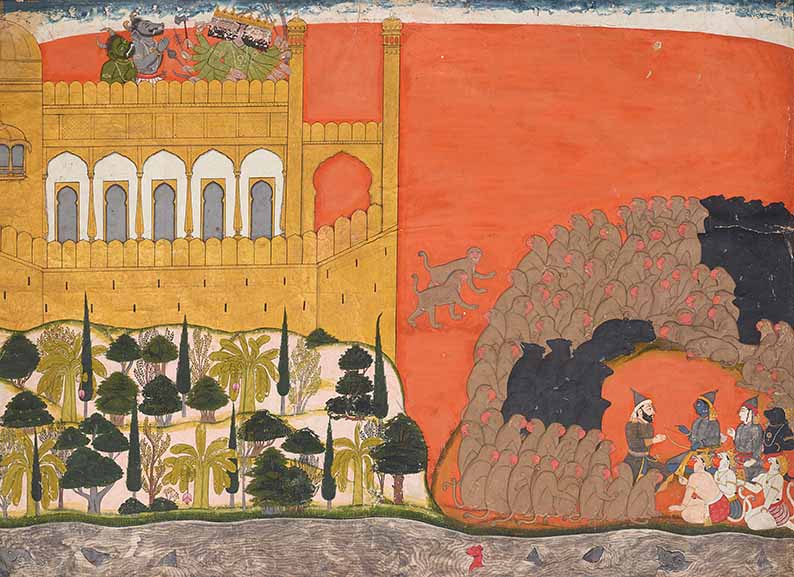Among the Museum Rietberg’s Indian treasures, the collection of historical miniature paintings is of special significance. Now, for the first time, this exhibition examines the oeuvre of two legendary artist brothers, Manaku and Nainsukh, by way of comparison.
The artist family from Guler, in the Pahari region of the Himalayas, heralded a turn in Indian painting in the second half of the 18th century. In his painting, Manaku, the elder brother, captured mythical tales on paper with the aid of colour and imagination, whilst his younger brother Nainsukh relied on refinement and sensitivity to shed an intimate light on life at a rajah’s court and portray the many different of life encountered at court.
The Guler school is part of Pahari painting (of the hills), an umbrella term for North Indian miniatures made in Himachal Pradesh and Jammu & Kashmir states of India. These paintings developed and flourished from the period of 17th to 19th centuries and were executed mainly in miniature form. The types of paintings can be divided into two distinct categories, on the basis of their geographical range, and style: Basohli and Kulu Style and Guler and Kangra Style. Pahari-style paintings, in general, were widely influenced by works produced at the Rajput courts, in response to the family relations of the Pahari Rajas with royal courts in Rajasthan. The Punjab hill states of the Himalayan foothills, in the late 18th century, were flourishing and went through a remarkable period of growth, several artists and families of artists competed with each other to produce new types of works that had not been seen before. This surge in creativity was helped by patronage and wealth of the smaller Himalayan courts of the region.
Francesca Galloway in the catalogue Pahari Paintings from the Eva and Konrad Seitz Collection states that with the weakening of Mughal power in the early 18th century Mughal artists sought patronage elsewhere, some presumably seeking work at the hill courts, because, by about 1730, Pahari painting began to change. It moved towards a more naturalistic style, assimilating some of the canons of Mughal painting, in which the depiction of volume, space and landscape became progressively more important for the expression of poetical moods. This phase of Pahari painting is especially associated with the Guler artists Pandit Seu and his sons Manaku and Nainsukh, who were especially influenced by the contemporary Mughal style and may indeed have visited Delhi. Nainsukh, the most famous name in Pahari painting, is renowned for his portrayal of his patron Raja Balwant Singh of Jasrota in all of his many moods. This familial style was continued by their sons and grandsons who influenced the whole Pahari area but especially the large state of Kangra ruled by Raja Sansar Chand (reigned 1775-1823). This dominance gave the name of Kangra to much of the painting production of this later period, which is renowned for its lyrical interpretation of poetical Vaishnava texts.
Nainsukh was born circa 1710-1720 in the hills of Himachal Pradesh into a family of already established artists and learnt his craft under the supervision of his father, Pandit Seu, who was head of one of the most important families of painters in the Pahari region. Pandit Seu seems to have travelled outside his mountainous region and come into contact with artists from the plains, who were already working in the naturalistic, late Mughal style. The father was active at the time when the puritanical Mughal Emperor Aurangzeb had begun disbanding the Mughal atelier in Delhi, and as work ran out in Delhi artists returned to the smaller courts, such as Guler, to seek patronage and work.
Documentation of Nainsukh’s work starts around 1740, when he was already working for a princely patron in Jasrota, a small Himalayan principality in the state of Jammu. He started work for the local Rajput ruler Mian Zorowar Singh and remained in the service of Balwant Singh, the son, until Balwant Singh’s death in 1763. Balwant Singh was considered a minor prince even in the small world of Jasrota, and perhaps it was the lack of formality and pomp associated with the major royal houses and greater courts that allowed Nainsukh to depict his patron in so many different aspects of his everyday life. Surviving portraits by Nainsukh show Balwant Singh having his beard trimmed, writing a letter in a tent, smoking his huqqa in a garden, examining a horse, walking the ramparts of his fort, hunting with hawks, listening to music, worshipping/doing puja, as well as inspecting construction of a building. In the paintings, the prince was portrayed as a living being, a person, rather than a symbol of power. The painter and the prince seemed to have had an unusually close and relaxed relationship. In the Rietberg exhibition, we see Balwant Singh viewing a painting of Krishna whilst smoking a huqqa with the artist Nainsukh (a self-portrait by the artist) standing behind and a group of musicians playing in front. A double portrait of Mian Zorawar Singh and his son Balwant Singh is also included in the exhibition.
In the Rietberg exhibition Manaku of Guler, Nainsukh’s older brother, has work from the Ramayana and Gita Govinda series. Little detail is known of Manaku’s life and he was not known to have had a specific patron, however, it is documented that he was responsible for at least three great series of illustrations for Hindu epics: the Siege of Lanka which he continued the narrative of the Ramayana from the point where his father, Pandit Seu, had left it; as well as painting illustrations for the Gita Govinda and the Bhagavata Purana.
Family Ties: Nainsukh and Manaku, from 4 October to 17 February 2019, at the Rietberg Museum, Zurich, rietberg.ch






